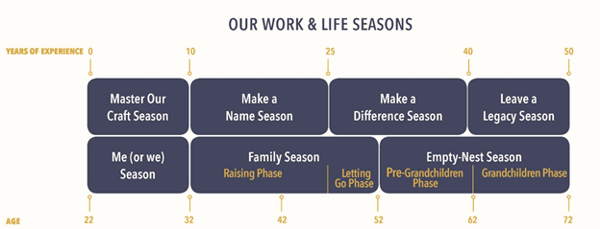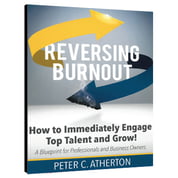 Has the new year already lost its luster?
Has the new year already lost its luster?
Are you or your architecture/engineering firm leadership team already feeling overwhelmed or uninspired?
We are living in a new era. Our personal and professional goals have expanded, change is accelerating, and so many of us in leadership and management continue to be too busy and consumed.
A well-designed sabbatical program will combat the growing epidemic of burnout and disengagement and ensure your organization’s success over the long-term. And, at least right now, it can position you to be different and more attractive in the workplace, marketplace, and recruiting space.
Here are the benefits:
1. Planned Refresh Cycles
Top leaders and organizations realize that not every season can be a harvest season if they are to attract and retain the best talent and achieve long-term growth.
More than ever, we need routine refresh cycles – likely every 7 to 15 years – to grow and excel over the long-term. These periods are also important in helping us successfully transition into new work and life seasons without falling prey to the otherwise inevitable “peaking” and “declining” phases.
Our typical seasons as professionals are illustrated in the graphic below (and you can also check out my past PSMJ blog entitled The New Rules for Employee Engagement – Part 4: Doing Our Job as Employees for more on our work and life seasons).

The Sigmoid or “s-curve” defines all human phenomena. And, as depicted in the graphic below, it is only through routine “pivoting” and new learning and development that we are able to continuously grow.

A well-designed and timed sabbatical program is more than annual “PTO”. It is a one, two, or three-month period away that allows us to focus on aspects of our lives – both inside and outside of the office – that we likely neglected in our busyness and need to either establish or re-establish.
Through my personal experience with burnout and my work with other executives, there are multiple approaches we can take to restore, rediscover, retarget, and revitalize.
The goal of any sabbatical should be to help us think bigger and more strategically about work and life, and to prevent and reverse the Burnout-Disengagement Cycle that is plaguing more and more of our organizations and leadership teams and stunting growth.
“An effective sabbatical program would have gone a long way to keep me engaged and thriving in my former firm and career as it was.” – Peter C. Atherton, P.E.
And while top senior talent is refreshing, top organizations can benefit too – especially in the areas of resilience testing, succession planning, and internal development – the areas often overlooked, postponed, or abandoned in our busyness.
2. Designed Resilience and Succession Planning
Key-person “protection” and the identification and development of future leaders is essential to propel organizations forward and improve value for all stakeholders.
A sabbatical program can be designed to provide this protection in a planned and methodical manner – and without an emergency.
Such a program works to continuously identify successors and provide targeted opportunities to further develop and “test drive” this talent while increasing connectedness and support throughout an organization while others are away.
3. Designed Teamwork and Engagement
What happens at the highest levels of any organization filters into all levels and forms the basis for its culture.
A sabbatical program can be designed to help establish the type of culture desirable by targeting senior-level talent, including operational boards of directors and executive management teams.
Well in advance of a senior leader’s time away, an effective strategy requires peer-to-peer teamwork, collaboration, and reciprocity to ensure all internal and external needs are met during the sabbatical. This builds awareness and improves communication, trust, and camaraderie amongst senior leaders – and throughout the firm.
The program would also require one’s staff development to be a priority in order to ensure smooth operations while away. This would build engagement and loyalty within a leader’s team, especially with the “high-potentials” who are likely to be looking forward to these opportunities to demonstrate their capabilities and shine.
4. Differentiator in the Marketplace and Recruiting Space
All things being equal, who wouldn’t want to work for an organization or leadership team who cares enough about the long-term growth and development of its best talent that it offers sabbaticals?
What client wouldn’t want to be served by an organization that offers great teamwork, engagement, growth, loyalty, and stability?
It’s really a no-brainer if we take the time to think about it!
The only real question is how best to do so in the context of our talent and our organization today.
Act Now to Win
Like so many of the essential “people” and “purpose” aspects of our business, time is not our friend if we want to standout.
The benefits of an effective sabbatical program are so clear that it is just a matter of time before your competitors develop one as an essential strategy to attract, engage, develop, and retain top talent.
Don’t be left behind! We can begin today to take advantage of a proven concept to win personally, professionally, and organizationally.
About the Author: Peter C. Atherton, P.E. is an A/E industry insider having spent more than 24 years as a successful professional civil engineer, principal, major owner, and member of the board of directors for high-achieving firms. Pete is now the President and Founder of ActionsProve, LLC (www.actionsprove.com), author of Reversing Burnout. How to Immediately Engage Top Talent and Grow! A Blueprint for Professionals and Business Owners, and the creator of the I.M.P.A.C.T. process. Pete is also host of The AEC Leadership Today Podcast (https://actionsprove.com/podcast/).
 Reversing Burnout. How to Immediately Engage Top Talent and Grow! A Blueprint for Professionals and Business Owners uses a thorough and easy-to-follow approach, that only an engineer can provide. Peter Atherton presents the promise and the opportunities of the new professional and organizational landscape. As engineering is the practical application of science, Reversing Burnout is the practical application of the new era we’re in to reverse professional and executive burnout, improve employee engagement, and grow.
Reversing Burnout. How to Immediately Engage Top Talent and Grow! A Blueprint for Professionals and Business Owners uses a thorough and easy-to-follow approach, that only an engineer can provide. Peter Atherton presents the promise and the opportunities of the new professional and organizational landscape. As engineering is the practical application of science, Reversing Burnout is the practical application of the new era we’re in to reverse professional and executive burnout, improve employee engagement, and grow.
You also might be interested in these posts by Peter C. Atherton, P.E: The New Rules of Employee Engagement – Part 1: Know Your RoleThe New Rules of Employee Engagement – Part 2: Doing Our Job as LeadersThe New Rules of Employee Engagement – Part 3: Doing Our Job as ManagersThe New Rules for Employee Engagement – Part 4: Doing Our Job as Employees



